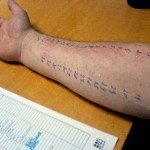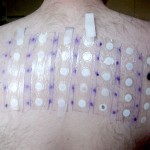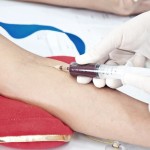Have you ever experienced a sudden onset of unusual symptoms after eating certain foods or after exposure to certain substances? Symptoms such as hives, flushing, a swollen mouth, throat or face could be signs that you are having an allergic reaction. If you think that you might be allergic to any foods including, among others, fish, tree-nuts or peanuts, or have experienced any allergy symptoms after exposure to products such as such as latex, hair dye or cosmetics, you should make an appointment to see your doctor.
The most extreme symptom of many allergies is anaphylaxis, a rare, potentially life-threatening condition. If your doctor decides that you may be at risk of anaphylaxis you will be prescribed equipment for self-administration of epinephrine, for immediate use once the first symptoms of anaphylaxis appear.
How do they test for allergies?
During the appointment your doctor will take a full history of your symptoms and may conduct a physical examination. They may refer you for tests to help determine whether you have a true allergy, as opposed to an intolerance or sensitivity to the substance.
Types of tests for allergies
Your doctor may decide to refer you to an allergy specialist or hospital clinic for one or more of the tests listed below. As there is a slight risk of the tests themselves provoking a severe reaction it is important that these tests are performed in the presence of a qualified clinician with emergency medication and equipment at hand. The tests are therefore usually performed in hospital.
The skin prick / scratch test
A tiny amount of the allergen is placed on the skin, usually on the forearm. The skin is then pricked or scratched to observe whether a reaction occurs. This is the most commonly performed test used by doctors to test for food allergies.
The intradermal test
In this test the potential allergen is injected under the skin. This test, which is often used to test for allergies to penicillin and to insect venom, is more sensitive than the skin prick test.
The skin patch test
This test is used to test for contact dermatitis, a type of eczema which occurs after exposure to a substance such as nickel, cleaning products or solvents to which the person is either allergic or sensitive. A solution containing the potential allergen is placed on pads which are then taped to the skin (usually the back). The patient is then sent home with instructions to return, usually 48 hours later. During the second appointment, the skin is examined. The whole procedure may be repeated more than once, to test for delayed reactions.
Blood tests
Blood tests might be used to test levels of immunoglobulin E in the blood. Immunoglobulin E (IgE) is an antibody produced by the immune system when an individual suffers an allergic reaction.
Allergy Challenge
If the above tests are inconclusive, it may be decided to do an allergy challenge test as a last resort. During the challenge the patient is given small amounts of the suspected allergen, in order to observe the reaction. If a reaction occurs it is clear that an allergy is present and the test is immediately discontinued. Because of the risk of a potentially life-threatening reaction, this must only ever be done in a hospital, under close medical supervision, with emergency treatment at hand. Only one substance can be tested for at each appointment, and the appointment may last for as long as 5 hours.
How accurate are the tests?
Apart from the allergy challenge, none of the above tests are 100% accurate. They fairly often produce false positives, predicting an allergy where there is none present, and occasionally also produce false negatives, suggesting that no allergy is present when in fact the patient is allergic to the substance. Whichever tests you are recommended, the doctor interpreting the test results will be fully aware of the potential unreliability of the tests. They will therefore use the test results together with other diagnostic tools, including your full medical history to help decide whether you suffer from a genuine allergy.
Is it a good idea to visit a Complimentary/ Alternative Practitioner for an allergy diagnosis?
Because of the potentially life-threatening nature of a true allergy, if you suspect an allergy, you should see your doctor. Complementary / alternative testing or treatment should never be used as an alternative treatment for true allergy. If you decide to see an alternative therapist for treatments which may compliment your conventional allergy treatment, it’s a good idea to ask your doctor which alternative therapists they might recommend.


